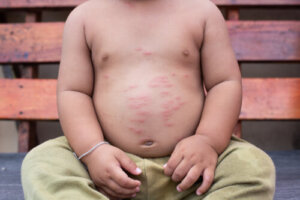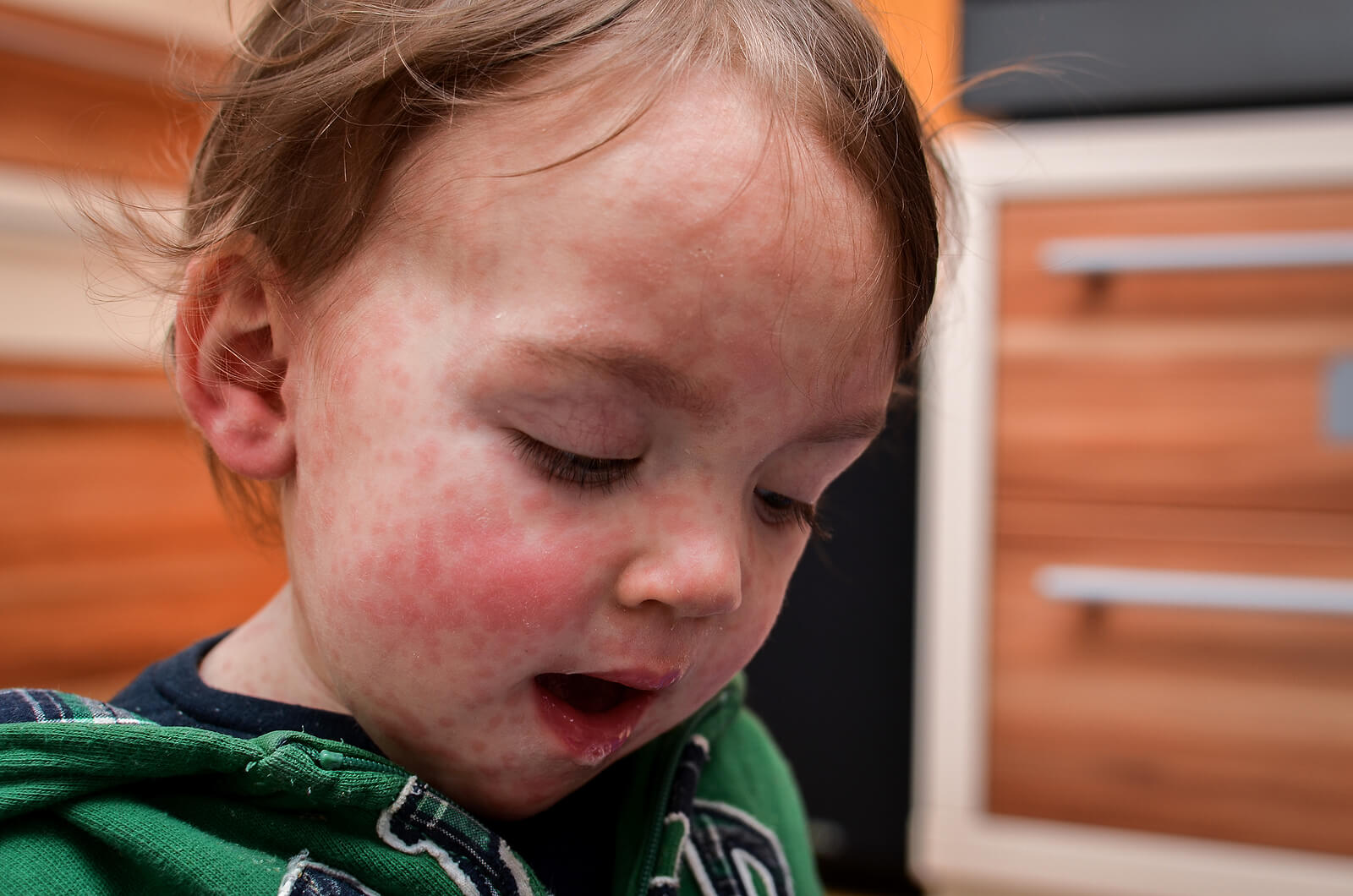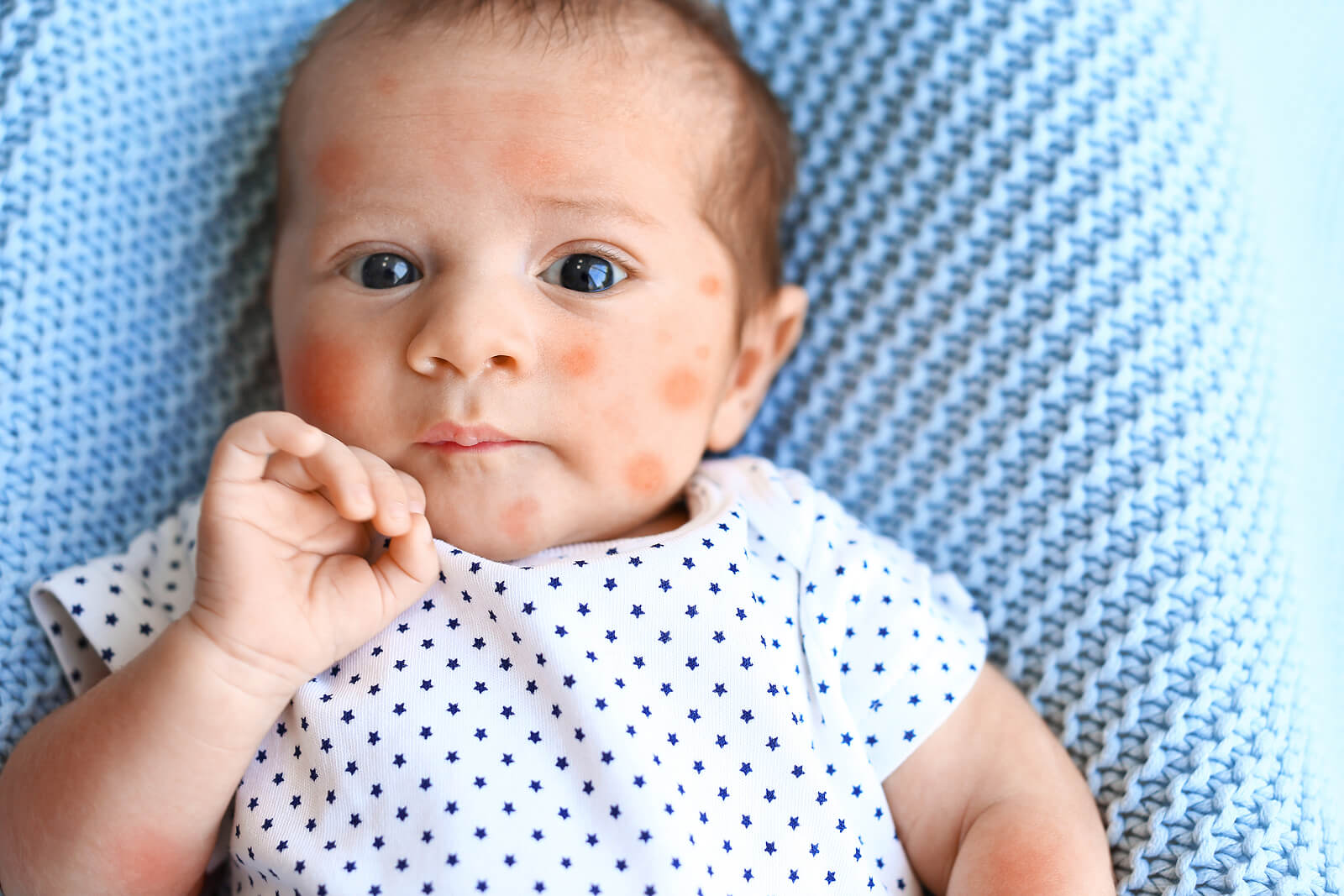Children with Skin Allergies: Symptoms and Recommendations


Written and verified by the dermatologist Maria del Carmen Hernandez
Children are more prone to develop skin allergies because their skin surfaces aren’t fully developed. That’s to say, the skin is more sensitive and delicate compared to that of the adult. This’s why it’s important to take the necessary care and hygiene measures to keep the skin barrier functional.
Children with skin allergies
Skin allergies are the manifestation of immune system reactions to certain plants, insects, animals, or foods.
Food allergies

Childhood food allergies are a rapidly growing public health problem. Overall, 220-250 million people worldwide have food allergies, with children making up the majority of cases.
Eight foods are responsible for around 90% of food allergies in children:
- Peanuts
- Nuts
- Eggs
- Cow’s milk
- Soybeans
- Fish
- Wheat
- Shellfish
Pollen and grass allergies are also frequent. In the case of foods, once the one that triggers the allergic outbreaks has been established, it should be removed from the daily diet.
A radioallergosorbent test (RAST) can also be performed, in which a blood sample taken from the child is mixed with different compounds from foods to determine which of them the body reacts negatively to.
Find out more: The Symptoms of Food Allergies in Children
Contact dermatitis
Contact dermatitis is a common disease in the pediatric age group. In turn, it has its irritant and allergic forms. The substances responsible for contact dermatitis in children may be physical or chemical agents causing irritant contact dermatitis or sensitizers causing allergic contact dermatitis.
Clinical manifestations may include localized pruritic eczematous reactions at the site of contact with the incriminated substance.
Allergic forms may appear at a distance, while irritant forms may result in erythematous desquamative or blistering lesions.
In turn, contact with metals increases exponentially during school age and adolescence. The most common causative agents are nickel, cobalt, and chromium.
Allergies due to insect bites
An event as simple as an insect bite often triggers allergic reactions of varying severity in children. This is especially prevalent in those who spend a lot of time outdoors playing in the summer and come into contact with nature.
Wasps, bees, and even some types of ants can make stings quite problematic. This is due to the presence of toxins foreign to the human organism that trigger an immune reaction.
How do skin allergies manifest themselves?
Three of the most common cutaneous allergic clinical manifestations that occur in the pediatric age group are urticaria, angioedema, and atopic disease.
Urticaria
Urticaria is characterized by the presence of bumps and angioedema by the release of histamines and other mediators from mast cells. The treatment of urticaria is based on 2 pillars:
- Pharmacological treatment
- Avoiding triggering and aggravating factors
The use of oral corticosteroids should be for short periods and their chronic use should be avoided. Between 25% and 40% of chronic urticaria are refractory and require systemic treatment.
According to the journal Alergia Mexico, the most common subtypes of urticaria in allergy services are spontaneous, papular, drug-induced, and dermographic urticaria.
Atopic disease
Atopic dermatitis is a chronic, relapsing, early-onset inflammatory skin disease with a lifetime prevalence of about 20%. The appearance of the individual skin lesion in atopic dermatitis doesn’t differ from other eczemas such as contact dermatitis.
In its acute form, eczema is characterized by the following patterns:
- Bright red infiltrate with edema
- Vesicles
- Suppuration
- Crusting
While the subacute and chronic form involves lichenification, excoriations, papules, and nodules, the severity of eczema can be classified according to scoring systems such as SCORAD and EASI.
Atopic dermatitis in children: 3 Forbidden Foods for Children with Atopic Dermatitis
Angioedema
Angioedema is sudden swelling that doesn’t form depressions in the skin, mucous membranes, or both. Swelling of the tongue, pharynx, and larynx are problematic situations and should be resolved and tended to urgently.
The World Allergy Organization states that cases of urticaria and angioedema have been reported in up to 20% of the general population.

How to prevent or identify skin allergies in children
It’s important to incorporate complementary feeding from 6 months of age. In this regard, organic foods have become increasingly popular and are therefore preferred.
Processed foods should also be avoided and foods should be incorporated one by one, paying attention to the clinical manifestations that may appear.
It’s also advisable to eliminate the agents that trigger allergic reactions or aggravate them and, in turn, promote a healthy diet. Skin care is no less important in preventing allergic skin reactions in children. Consequently, proper daily moisturizing is ideal.
The same applies to basic measures such as the use of hypoallergenic products in the home, keeping children’s nails short (to avoid major injuries in case of scratching), and constantly cleaning the house.
It’s important to differentiate the occurrence of skin allergies from other conditions that can cause similar symptoms. For example, in summer, it’s quite common to observe heat rash, impetigo, cutaneous larva migrans, molluscum contagiosum, folliculitis, or ringworm. This’s why it’s important to consult a pediatric dermatologist.
Can skin allergies become complicated?
Although most allergic conditions affecting the skin don’t cause serious reactions, sometimes the opposite is true. Exposure to certain agents can cause a phenomenon known as anaphylaxis, in which life is compromised due to the affection of the cardiorespiratory system, mainly.
According to a study, in addition to skin reactions, those affected by anaphylaxis will experience difficulty breathing, coughing, fluid accumulation (edema), and hypotension, among other symptoms.
Skincare
Skincare is one of the necessary premises to take into account in the prevention of allergic skin reactions. Thus, constant and daily moisturizing, after bathing, contributes to the maintenance of the protective function of the skin barrier.
Children are more prone to develop skin allergies because their skin surfaces aren’t fully developed. That’s to say, the skin is more sensitive and delicate compared to that of the adult. This’s why it’s important to take the necessary care and hygiene measures to keep the skin barrier functional.
Children with skin allergies
Skin allergies are the manifestation of immune system reactions to certain plants, insects, animals, or foods.
Food allergies

Childhood food allergies are a rapidly growing public health problem. Overall, 220-250 million people worldwide have food allergies, with children making up the majority of cases.
Eight foods are responsible for around 90% of food allergies in children:
- Peanuts
- Nuts
- Eggs
- Cow’s milk
- Soybeans
- Fish
- Wheat
- Shellfish
Pollen and grass allergies are also frequent. In the case of foods, once the one that triggers the allergic outbreaks has been established, it should be removed from the daily diet.
A radioallergosorbent test (RAST) can also be performed, in which a blood sample taken from the child is mixed with different compounds from foods to determine which of them the body reacts negatively to.
Find out more: The Symptoms of Food Allergies in Children
Contact dermatitis
Contact dermatitis is a common disease in the pediatric age group. In turn, it has its irritant and allergic forms. The substances responsible for contact dermatitis in children may be physical or chemical agents causing irritant contact dermatitis or sensitizers causing allergic contact dermatitis.
Clinical manifestations may include localized pruritic eczematous reactions at the site of contact with the incriminated substance.
Allergic forms may appear at a distance, while irritant forms may result in erythematous desquamative or blistering lesions.
In turn, contact with metals increases exponentially during school age and adolescence. The most common causative agents are nickel, cobalt, and chromium.
Allergies due to insect bites
An event as simple as an insect bite often triggers allergic reactions of varying severity in children. This is especially prevalent in those who spend a lot of time outdoors playing in the summer and come into contact with nature.
Wasps, bees, and even some types of ants can make stings quite problematic. This is due to the presence of toxins foreign to the human organism that trigger an immune reaction.
How do skin allergies manifest themselves?
Three of the most common cutaneous allergic clinical manifestations that occur in the pediatric age group are urticaria, angioedema, and atopic disease.
Urticaria
Urticaria is characterized by the presence of bumps and angioedema by the release of histamines and other mediators from mast cells. The treatment of urticaria is based on 2 pillars:
- Pharmacological treatment
- Avoiding triggering and aggravating factors
The use of oral corticosteroids should be for short periods and their chronic use should be avoided. Between 25% and 40% of chronic urticaria are refractory and require systemic treatment.
According to the journal Alergia Mexico, the most common subtypes of urticaria in allergy services are spontaneous, papular, drug-induced, and dermographic urticaria.
Atopic disease
Atopic dermatitis is a chronic, relapsing, early-onset inflammatory skin disease with a lifetime prevalence of about 20%. The appearance of the individual skin lesion in atopic dermatitis doesn’t differ from other eczemas such as contact dermatitis.
In its acute form, eczema is characterized by the following patterns:
- Bright red infiltrate with edema
- Vesicles
- Suppuration
- Crusting
While the subacute and chronic form involves lichenification, excoriations, papules, and nodules, the severity of eczema can be classified according to scoring systems such as SCORAD and EASI.
Atopic dermatitis in children: 3 Forbidden Foods for Children with Atopic Dermatitis
Angioedema
Angioedema is sudden swelling that doesn’t form depressions in the skin, mucous membranes, or both. Swelling of the tongue, pharynx, and larynx are problematic situations and should be resolved and tended to urgently.
The World Allergy Organization states that cases of urticaria and angioedema have been reported in up to 20% of the general population.

How to prevent or identify skin allergies in children
It’s important to incorporate complementary feeding from 6 months of age. In this regard, organic foods have become increasingly popular and are therefore preferred.
Processed foods should also be avoided and foods should be incorporated one by one, paying attention to the clinical manifestations that may appear.
It’s also advisable to eliminate the agents that trigger allergic reactions or aggravate them and, in turn, promote a healthy diet. Skin care is no less important in preventing allergic skin reactions in children. Consequently, proper daily moisturizing is ideal.
The same applies to basic measures such as the use of hypoallergenic products in the home, keeping children’s nails short (to avoid major injuries in case of scratching), and constantly cleaning the house.
It’s important to differentiate the occurrence of skin allergies from other conditions that can cause similar symptoms. For example, in summer, it’s quite common to observe heat rash, impetigo, cutaneous larva migrans, molluscum contagiosum, folliculitis, or ringworm. This’s why it’s important to consult a pediatric dermatologist.
Can skin allergies become complicated?
Although most allergic conditions affecting the skin don’t cause serious reactions, sometimes the opposite is true. Exposure to certain agents can cause a phenomenon known as anaphylaxis, in which life is compromised due to the affection of the cardiorespiratory system, mainly.
According to a study, in addition to skin reactions, those affected by anaphylaxis will experience difficulty breathing, coughing, fluid accumulation (edema), and hypotension, among other symptoms.
Skincare
Skincare is one of the necessary premises to take into account in the prevention of allergic skin reactions. Thus, constant and daily moisturizing, after bathing, contributes to the maintenance of the protective function of the skin barrier.
All cited sources were thoroughly reviewed by our team to ensure their quality, reliability, currency, and validity. The bibliography of this article was considered reliable and of academic or scientific accuracy.
- Stern AH, Bagdon RE, Hazen RE, Marzulli FN. Risk assessment of the allergic dermatitis potential of environmental exposure to hexavalent chromium. J Toxicol Environ Health. 1993 Dec;40(4):613-41. doi: 10.1080/15287399309531822. PMID: 8277522.
- Anvari S, Chokshi NY, Kamili QU, Davis CM. Evolution of Guidelines on Peanut Allergy and Peanut Introduction in Infants: A Review. JAMA Pediatr. 2017 Jan 1;171(1):77-82. doi: 10.1001/jamapediatrics.2016.2552. PMID: 27820622.
- Sánchez-Borges M, Capriles-Hulett A, Caballero-Fonseca F, González-Aveledo L. Urticaria en niños atendidos en servicios de alergología [Urticaria in children attending allergy services]. Rev Alerg Mex. 2014 Apr-Jun;61(2):90-8. Spanish. PMID: 24915621.
- Severity scoring of atopic dermatitis: the SCORAD index. Consensus Report of the European Task Force on Atopic Dermatitis. Dermatology. 1993;186(1):23-31. doi: 10.1159/000247298. PMID: 8435513.
- Hanifin JM, Thurston M, Omoto M, Cherill R, Tofte SJ, Graeber M. The eczema area and severity index (EASI): assessment of reliability in atopic dermatitis. EASI Evaluator Group. Exp Dermatol. 2001 Feb;10(1):11-8. doi: 10.1034/j.1600-0625.2001.100102.x. PMID: 11168575.
This text is provided for informational purposes only and does not replace consultation with a professional. If in doubt, consult your specialist.








